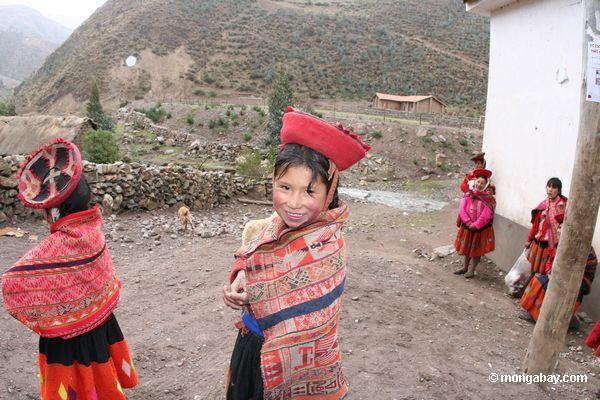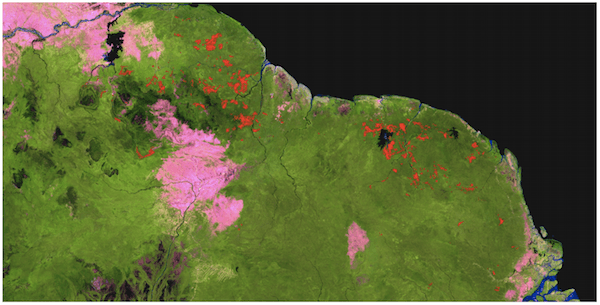Dr. Thomas Gillespie is concerned with the connections between conservation and disease, with a particular emphasis on primates. Much of his research examines the places where humans and animals are at a high risk of exchanging pathogens, and how human-caused disturbances, such as deforestation, can change disease dynamics and impacts. Through his research and conservation efforts in Africa and Latin America, he works to promote human, wildlife and ecosystem health.
“The central hypothesis of much of my work is that key human behaviors, wildlife behaviors, ecological conditions, and landscape features associated with anthropogenic disturbance alter disease dynamics and increase the risk of interspecific disease transmission,” Gillespie told mongabay.com. In other words, forest loss or degradation may be exacerbating disease outbreaks both in wildlife and humans.
Moreover, said Gillespie, the disease’s knock on effects may change a forest’s ecology: “Insights over the past three decades have clarified how the health and persistence of tropical forest systems depend on critical ecosystem services provided by wildlife… it is now becoming clear that infectious diseases affecting wildlife have the capacity to impact tropical forest systems in similar ways...We’ve lost pollinators—honeycreeper declines in Hawaii due to introduced malaria; seed dispersers—lowland gorilla declines due to Ebola; and indicator species—frog declines and extinctions due to chytrid fungus.”
Research on the impact of diseases on endangered species and wild animals has risen significantly over the past decade, and the use of non-invasive sampling tools such as fecal assays have proven simpler and more cost effective than collecting samples from live animals. One emerging technology that excites Gillespie is the using invertebrates such as mosquitoes, leeches and carrion flies to collect information. Because these organisms feed on wild animals, researchers can use DNA from the blood inside their guts to tell us what animals were fed on, and sometimes, what diseases are present.
“This is especially interesting in regards to carrion flies,” Gillespie said. Because carrion flies usually feed on dead and dying animals we can use them to “provide an inventory of faunal and pathogen diversity including data on the presence or absence of cryptic [unidentified] species. In addition, this method may alert wildlife managers to major mortality events.”
More data may lead to even clearer links between forest destruction and disease outbreaks, both for wildlife and humans.
Thomas Gillespie is currently Associate Professor of Environmental Sciences and Environmental Health at Emory University and the Rollins School of Public Health in Atlanta, USA. He is a distinguished STAR Fellow of the U,S. Environmental Protection Agency, a member of the IUCN Primate Specialist Group, the Species Survival Commission, and the United Nations Environment Programme’s Working Group on Best Practices for Great Ape Health.
AN INTERVIEW WITH DR. THOMAS GILLESPIE
Mongabay: What is your background? How long have you worked in tropical forest conservation and in what geographies? What is your area of focus?
Thomas Gillespie: My work is at the interface of biodiversity conservation and global health with a particular emphasis on primates. As an undergraduate at the University of Illinois, I was fortunate to have Carol Augspurger and Paul Garber as instructors and mentors—both were instrumental in guiding my development as a research scientist and conservationist. While a graduate student at the University of Florida, I continued to strengthen my focus in tropical ecology with guidance from Colin Chapman, John Eisenberg, and many other members of the ‘Florida mafia’ (an insider term for the major influence of the University of Florida from 1990 to 2000 in tropical ecology and conservation), while simultaneously expanding my understanding of disease within natural systems through coursework and discussions with Ellis Greiner, Ben Bolker, Bob Holt, Don Forrester, and Marilyn Spalding. Although my career has been dominated by work in forested Africa, my earliest experiences were in Central America and the Amazon, and I’ve had the opportunity to continue some work in the Neotropics over the years. The central hypothesis of much of my work is that key human behaviors, wildlife behaviors, ecological conditions, and landscape features associated with anthropogenic disturbance alter disease dynamics and increase the risk of interspecific disease transmission. This effort entails a combination of epidemiology, molecular ecology, behavioral ecology, social and clinical survey, and spatially explicit modeling.
Mongabay: What do you see as the biggest development or developments over the past decade in tropical forest conservation?
Thomas Gillespie: Disease matters! —Insights over the past three decades have clarified how the health and persistence of tropical forest systems depend on critical ecosystem services provided by wildlife. We now know that density-dependent seedling mortality presents a strong selective pressure for seed dispersal for tropical tree species to escape seedling pathogens (Augspurger 1984). We also have seen the potential of unsustainable hunting to create “empty forests”, where loss of keystone species results in reduced seed dispersal and altered recruitment and relative abundance of trees (Redford 1992). John Terborgh and colleagues elegantly demonstrated that seedlings and saplings of canopy trees are severely reduced and seed predation exponentially increases when top predators are lost from atropical system (Terborgh et al. 2001). The decline or loss of the seed dispersers, pollinators, seed predators, herbivores, and predators that shape tropical forest ecosystems, have long been attributed to habitat degradation or loss and unsustainable hunting. However, it is now becoming clear that infectious diseases affecting wildlife have the capacity to impact tropical forest systems in similar ways. We’ve lost pollinators—honeycreeper declines in Hawaii due to introduced malaria (Benning et al. 2002); seed dispersers—lowland gorilla declines due to Ebola (Leroy et al. 2004); and indicator species—Frog declines and extinctions due to chytrid fungus (Lips et al. 2006).
Mongabay: What’s the next big thing in forest conservation? What approaches or ideas are emerging or have recently emerged? What will be the catalyst for the next big breakthrough?
Thomas Gillespie: In the past decade, technological advances in non-invasive pathogen surveillance have allowed us to make great strides in understanding how infectious diseases may threaten endangered species (i.e., fecal assays to examine respiratory pathogens and blood-borne pathogens like malaria and immunodeficiency viruses). Similarly, an exciting innovation that’s just taking off is letting mosquitos, leeches, and carrion flies do the work for us! All of these invertebrates seek out wildlife for a meal. By trapping them and analyzing their gut contents, we can determine which wildlife species they fed on, and in some cases, the pathogens that infected those individuals. This is especially interesting in regards to carrion flies, since they feed more or less indiscriminately on dead or dying animals. As a result, screening large numbers of carrion flies in a selected tropical forests could provide an inventory of faunal and pathogen diversity including data on the presence or absence of cryptic species. In addition, this method may alert wildlife managers to major mortality events (i.e., based on anomalies in the frequency and amount of DNA from a specific vertebrate species being recovered).
Mongabay: Are you personally involved in any projects or research that represent emerging innovation in tropical forest conservation?
Thomas Gillespie: Acquiring data on infectious diseases in tropical wildlife populations has been limited in the past due to costs, logistical challenges, and the technological limitations of non-invasive sampling; however, recent improvements in sample preservation, diagnostic capacity, and greater sampling effort are rapidly improving our understanding of the epidemiology and threat of various pathogens to tropical wildlife and people. In my own work, we are making use of these innovations while using a mixed-methods approach to understand disease dynamics on multiple fronts.
A couple of examples:
In and around Ranomafana National Park in Madagascar, we are examining whether improved healthcare for the local human population can serve as the lever to pull people out of the poverty traps that have forced them to rely on unsustainable degradation of forests. Simultaneously, we are examining how forest degradation and human overlap relate to pathogen exposure in wild lemurs. This transdisciplinary undertaking, funded by the Grand Challenges Program of the Gates Foundation and the Herrnstein Foundation, results from the collaboration of researchers and conservation and health practitioners of the Centre Valbio and Pivot.
In the greater Gombe Ecosystem in Tanzania, where Jane Goodall conducted her pioneering research on chimpanzee behavior, we now have over fifty years of demographic and behavioral data, thirteen years of SIV prevalence data, ten years of syndromic health (ie. signs of gastro-intestinal and respiratory illness) and fecal macro- and micro-parasitic data, making the Gombe chimpanzees arguably the best characterized wild ape population in relation to health and disease-related threats. A disease risk analysis determined that infectious disease plays an important role in the observed and ongoing decline of the Gombe chimpanzee population, sparking the initiation of our prospective health monitoring system, the Gombe EcoHealth Project. After more than 12 years of non-invasive screening of chimpanzees for SIVcpz, it is now clear that there are differences in survival and fecundity between SIVcpz+ and SIVcpz – negative cohorts. In addition, mixed-methods approaches have allowed us to examine the natural history of this disease and risk factors including opportunistic zoonotic and natural infections that contribute to these differences. One key component of this effort has been to examine the epidemiology and zoonotic transmission dynamics of pathogenic bacterial and parasitic enterics at the interface of the park and neighboring human communities, where diarrheal disease is a health priority.
Mongabay: What isn’t working in conservation but is still receiving unwarranted levels of support?
Thomas Gillespie: Reintroduction of sanctuary animals—when a wild animal is rescued from poachers or wildlife smugglers, if they’re lucky, they end up in a sanctuary. These facilities provide an essential service for animal welfare, providing veterinary care and rehabilitation in an environment where animals can interact with others of their own species. It’s intuitive to think that the best outcome for such an animal would be to eventually return to the wild. Unfortunately, despite the best intentions, reintroductions often result in unintended consequences for the welfare of the reintroduced individual (i.e. difficulty competing with resident populations for food and mates and avoiding unfamiliar predators). In addition, reintroductions may threaten the viability of wild populations by inadvertently exposing wildlife to novel pathogens contracted by sanctuary animals from humans or domestic animals during captivity. Our recent observation of high prevalence of drug-resistant human Staphylococcus aureus in sanctuary apes highlights this concern.
This article was originally written and posted by Liz Kimborough, a contributing author for news.mongabay.com. Please go to their website for more information or to see the original article, news.mongabay.com




